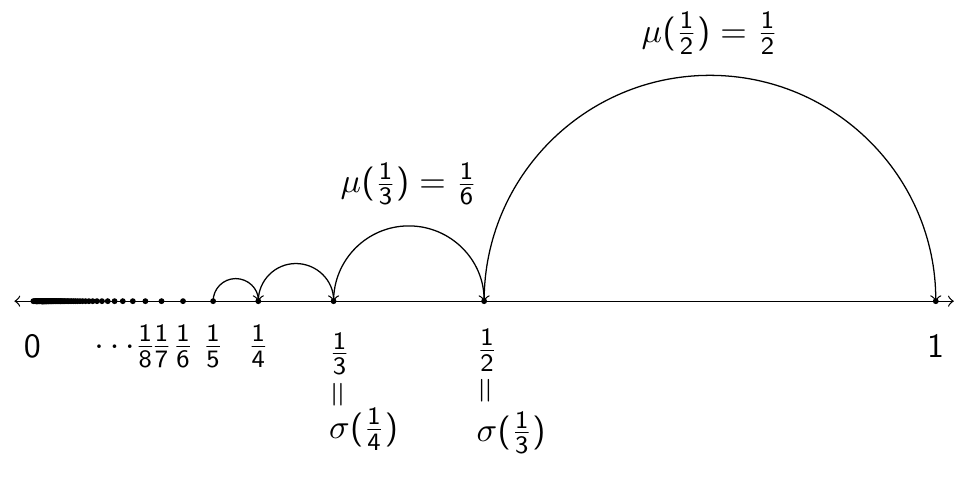Closure of unit fractions
From timescalewiki
The set $\overline{\left\{\dfrac{1}{n} \colon n \in \mathbb{Z}^+\right\}}=\left\{ 0,1,\dfrac{1}{2},\dfrac{1}{3},\ldots \right\}$, where the $\overline{\mathrm{overline}}$ denotes topological closure of this set in the usual topology on $\mathbb{R}$ is a time scale.
| Forward jump: | $\sigma(t)=$ | derivation |
| Forward graininess: | $\mu(t)=$ | derivation |
| Backward jump: | $\rho(t)=$ | derivation |
| Backward graininess: | $\nu(t)=$ | derivation |
| $\Delta$-derivative | $f^{\Delta}(t)=$ | derivation |
| $\nabla$-derivative | $f^{\nabla}(t)=$ | derivation |
| $\Delta$-integral | $\displaystyle\int_s^t f(\tau) \Delta \tau=$ | derivation |
| $\nabla$-integral | $\displaystyle\int_s^t f(\tau) \nabla \tau=$ | derivation |
| $h_k(t,s)$ | $h_k(t,s)=$ | derivation |
| $\hat{h}_k(t,s)$ | $\hat{h}_k(t,s)=$ | derivation |
| $g_k(t,s)$ | $g_k(t,s)=$ | derivation |
| $\hat{g}_k(t,s)$ | $\hat{g}_k(t,s)=$ | derivation |
| $e_p(t,s)$ | $e_p(t,s)=$ | derivation |
| $\hat{e}_p(t,s)$ | $\hat{e}_p(t,s)=$ | derivation |
| Gaussian bell | $\mathbf{E}(t)=$ | derivation |
| $\mathrm{sin}_p(t,s)=$ | $\sin_p(t,s)=$ | derivation |
| $\mathrm{\sin}_1(t,s)$ | $\sin_1(t,s)=$ | derivation |
| $\widehat{\sin}_p(t,s)$ | $\widehat{\sin}_p(t,s)=$ | derivation |
| $\mathrm{\cos}_p(t,s)$ | $\cos_p(t,s)=$ | derivation |
| $\mathrm{\cos}_1(t,s)$ | $\cos_1(t,s)=$ | derivation |
| $\widehat{\cos}_p(t,s)$ | $\widehat{\cos}_p(t,s)=$ | derivation |
| $\sinh_p(t,s)$ | $\sinh_p(t,s)=$ | derivation |
| $\widehat{\sinh}_p(t,s)$ | $\widehat{\sinh}_p(t,s)=$ | derivation |
| $\cosh_p(t,s)$ | $\cosh_p(t,s)=$ | derivation |
| $\widehat{\cosh}_p(t,s)$ | $\widehat{\cosh}_p(t,s)=$ | derivation |
| Gamma function | $\Gamma_{\overline{\left\{\dfrac{1}{n} \colon n \in \mathbb{Z}^+\right\}}}(x,s)=$ | derivation |
| Euler-Cauchy logarithm | $L(t,s)=$ | derivation |
| Bohner logarithm | $L_p(t,s)=$ | derivation |
| Jackson logarithm | $\log_{\overline{\left\{\dfrac{1}{n} \colon n \in \mathbb{Z}^+\right\}}} g(t)=$ | derivation |
| Mozyrska-Torres logarithm | $L_{\overline{\left\{\dfrac{1}{n} \colon n \in \mathbb{Z}^+\right\}}}(t)=$ | derivation |
| Laplace transform | $\mathscr{L}_{\overline{\left\{\dfrac{1}{n} \colon n \in \mathbb{Z}^+\right\}}}\{f\}(z;s)=$ | derivation |
| Hilger circle | derivation |
Examples of time scales |
||||||||
Real numbers |
Integers |
Multiples of integers |
Square integers |
Harmonic numbers |
Isolated points |
|||
nth root numbers |
Evenly spaced intervals |
Quantum, $q>1$ |
Quantum, $q<1$ |
Closure of unit fractions |
Cantor set |
|||
